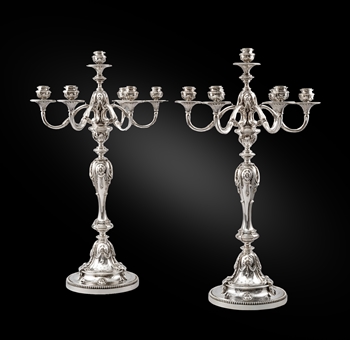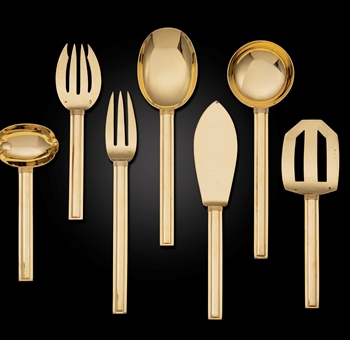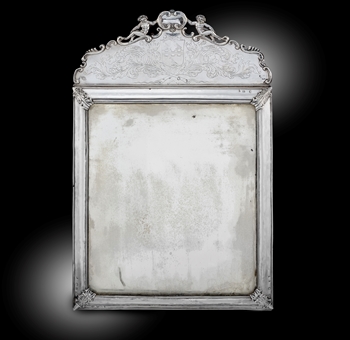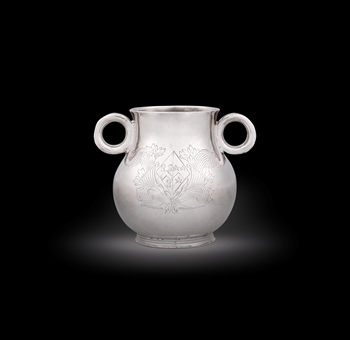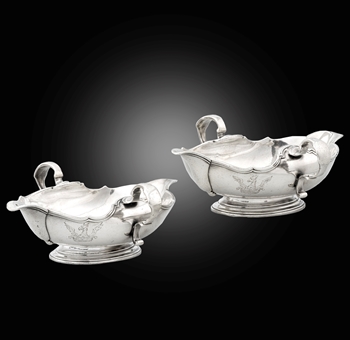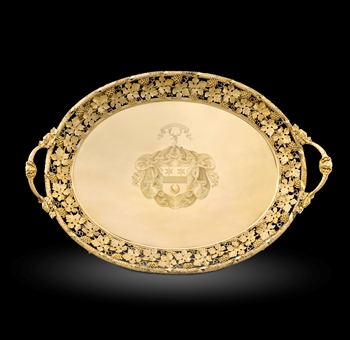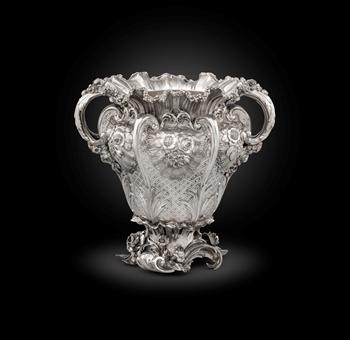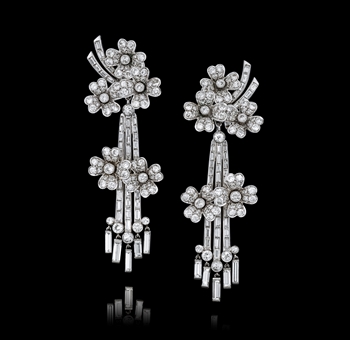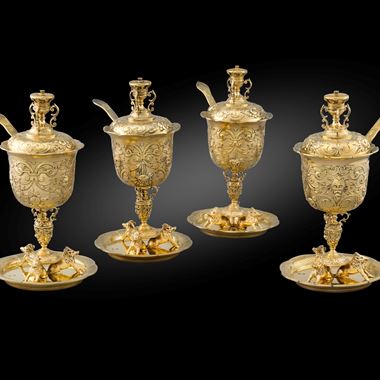Shaped oval, on four vine and shell feet, with reeded vine, acanthus and basket of grapes border, with acorn and oak branch handles, the centre engraved with a coat-of-arms under drapery mantle, marked on underside and stamped with pattern number 865
Robert Townley-Parker served as M.P. for Preston, Lancashire, 1837-1857, and was High Sheriff of the County in 1817. In 1816, he married Harriet, youngest daughter of Thomas Brooke on Minshall, Cheshire. Upon his death in 1879, the Illustrated London News, described Townley-Parker as ‘one of the chief proprietors among the landed gentry in the County of Lancaster’. His eldest son, Thomas, succeeded him. On his death in 1906, the manors land and chattels passed to his nephew Mr. Reginald Arthur Tatton of Chelford, in Cheshire.
Cuerden Hall, Lancashire, descended from the Cuerdens and Banasters to the Townley-Parker family, and was remodelled by Robert Townley-Parker in 1816-1819. Together with its landscaped park, Cuerden Hall was a significant early contribution to the nineteenth-century picturesque movement (J.M. Robinson, A Guide to the Country Houses of the North West, 1991, pp.176-177).
Other pieces from the extensive service of plate supplied to celebrate the marriage of Robert Townley-Parker and Harriet Brookes include a toasted cheese dish (M.A. Moss, The Lillian and Morrie Moss Collection of Paul Storr Silver, Miami, 1972, p.262, no.196) and a meat dish (Partridge, Christie’s New York, 17 May 2006, lot 143), each with the same distinctive border.
Supplied to Robert Townley-Parker (1793-1879) and Harriet Brooke of Cuerden Hall, Preston and Astley, in 1816 on the occasion of their marriage and by descent to
Their eldest son Thomas Townley-Parker (d. 1906) and by descent to his nephew Reginald Arthur Tatton and by descent to
Captain T.A. Tatton, M.C.
Captain T.A. Tatton, removed from Cuerden Hall, Preston;
Christie’s London, 12 December 1928, lot 33 (£281 to Holmes)
Son of Thomas Storr of Westminster, first silver-chaser later innkeeper, born 1771. Apprenticed c'1785. Before his first partnership with William Frisbee in 1792 he worked at Church Street, Soho, which was the address of Andrew Fogelberg. This is also the address at which Storr's first separate mark is also entered. First mark entered as plateworker, in partnership with William Frisbee, 2 May 1792. Address: 5 Cock Lane, Snow Hill. Second mark alone, 12 January 1793. Address: 30 Church Street, Soho. Third mark, 27 April 1793. Fourth 8 August 1794. Moved to 20 Air Street, 8 October 1796, (where Thomas Pitts had worked till 1793). Fifth mark, 29 November 1799. Sixth, 21 August 1807. Address 53 Dean Street, Soho. Seventh, 10 February 1808. Ninth, 21 October 1813. Tenth, 12 September 1817. Moved to Harrison Street, Gray's Inn Road, 4 March 1819, after severing his connection with Rundell, Bridge and Rundell. Eleventh mark, 2 September 1883. Address: 17 Harrison Street. Twelfth and last mark, 2 September 1833. Heal records him in partnership with Frisbee and alone at Cock Lane in 1792, and at the other addresses and dates above, except Harrison Street. Storr married in 1801, Elizabeth Susanna Beyer of the Saxon family of piano and organ builders of Compton Street, by whom he had ten children. He retired in 1838, to live in Hill House in Tooting. He died 18 March 1844 and is buried in Tooting Churchyard. His will, proved 3 April 1844, shows an estate of £3000. A memorial to him in Otely Church, Suffolk was put up by his son Francis the then incumbent of the parish. For full details of Storr's relationship with Rundell, Bridge and Rundell please see N.M. Penzer, 1954 or Royal Goldsmiths, The Art of Rundell and Bridge, 2005.
Storr's reputation rests on his mastery of the grandoise neo-Classical style developed in the Regency period. His early pieces up to about 1800 show restrained taste, although by 1797 he had produced the remarkable gold font for the Duke of Portland. Here, however the modelling of the classical figures must presumably have been the work of a professional sculptor, as yet unidentified, and many of the pieces produced by him for Rundell and Bridge in the Royal Collection must have sprung from designs commissioned by that firm rather than from his own invention. On the other hand, they still existed in his Harrison Street workshop, until destroyed in World War II, a group of Piranesi engravings of classical vases and monuments bearing his signature, presumably used as source material for designs. The massiveness of the best of his compositions is well shown in the fine urn of 1800 at Woborn Abbey, but the Theocritus Cup in the Royal Collection must be essentially ascribed to the restraint of its designer John Flaxman, while not denying to Storr its superb execution. Lord Spencer's ice pails of 1817 show similar quality. Not all Storr's work however was of classical inspiration. The candelabra of 1807 at Woburn derive from candlesticks by Paul Crespin of the George II period, formerly part of the Bedford Collection, and he attempted essays in floral rococo design from time to time, which tend to over-floridity. On occasions the excellence of his technical qualities was marred by a lack of good proportions, as in the chalices of the church plate of St Pancras, 1821. In spite of these small lapses there is no doubt that Storr rose to the demands made upon him as the author of more fine display plate than any other English goldsmith, including Paul De Lamerie, was ever called upon to produce.
You May Also Like






